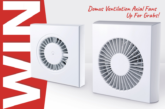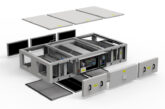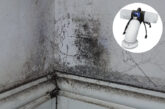
Penny Jones, Product & Marketing Manager at Domus Ventilation, explains the main ventilation systems and the four top things you need to know that impact system selection.
With buildings becoming increasingly air tight in a drive to improve energy efficiency and lower carbon emissions, the need for ‘pro-active’ ventilation has never been greater. It represents a genuine growth sector and one in which electricians are increasingly looking to move into.
Why Ventilate?
By correctly ventilating a property we not only bring in fresh external air to breath but we also dilute and remove airborne pollutants (including odours) and control excess humidity. Every single person reading this will know what it’s like to be in a poorly ventilated room, whether it be hot and stuffy or damp from condensation. It not only makes for an uncomfortable home environment but poor indoor air quality (IAQ) also has known links to allergies, asthma, lung cancer, chronic obstructive pulmonary disease, cardiovascular disease and even dementia.
Ventilation Requirements
Building Regulations Approved Document F, which details the means of ventilation in new and materially altered properties, sets the minimum continuous extraction requirement for domestic properties at 13l/s from the kitchen, 8l/s from each bathroom/utility area and supply at the same rate.
Clearly opening a window is never going to achieve this, which is where mechanical ventilation steps in.
Types of Ventilation Systems
System 1 – Intermittent Extract Ventilation
System 2 – Passive Stack Ventilation
System 3 – Continuous Mechanical Extract Ventilation (MEV)
System 4 – Continuous Mechanical Ventilation with Heat Recovery (MVHR)
To achieve the levels of extraction required under Building Regulations, MEV and MVHR whole house ventilation systems are necessary in most cases.
An MEV system actively extracts air from ‘wet rooms’ (kitchens, bathrooms, utility spaces) via ducting to a central ventilation unit which further ducts to an exhaust point. The systems are typically dual speed, providing low speed continuous trickle ventilation and high-speed boost flow. Replacement fresh air is drawn into the property via background ventilators located in the habitable rooms and through air leakage.
Unlike MEV, MVHR systems combine supply and extract ventilation in one system. They work on the principle of extracting and re-using waste heat from wet rooms. MVHR systems efficiently temper the fresh air drawn into the building with heat attained from waste stale air using a heat exchanger; up to 95% of waste heat can be recovered by this mechanism. The filtered, pre-warmed air is then distributed around the home, effectively meeting part of the heating load in energy efficient dwellings.
Key Considerations
All new homes can benefit from mechanical ventilation, but there are some aspects that it’s important to consider when specifying a system, based on the nature and location of the property.
Size: in larger properties, you have a far wider ranger of options in terms of the unit to use, where it’s located and how/where you run the ducting. In smaller properties, that choice is reduced. Installation of the main MEV/MVHR unit in the loft used to be common practice, but with access issues and potential problems caused by lower temperatures in the loft, most units are now wall mounted within the heated envelope of the property; most commonly in a cupboard. The size of the unit therefore needs to be compact, especially when it comes to height; the Domus Ventilation HRXE MVHR, for example, is just 507mm in height. Where installation in a cupboard is not an option, then a ceiling void should be a consideration. Here the depth of the unit and weight are key factors. The Domus Ventilation HRX-aQ is the shallowest in the market place, measuring down to 199mm in depth and weighing from just 7.9kg, making it compact and light enough to be easily installed in the most restrictive of ceiling voids.
Noise: nothing annoys a homeowner quite as much as being kept awake by a noisy appliance or building service. Mechanical ventilation systems aren’t silent but they can be very quiet. Opt for a system that generates less than 24dBA (typically whisper quiet) at a distance of more than one meter away from the air valve. Also, consider the use of an Anti-Vibration tray and duct sound attenuators to further reduce system noise.
Ducting: poor ducting (and that relates to the product quality, the duct run design and installation) impacts the air flow, sound and overall effectiveness of a system. Ensure quality ducting is used that fits together to minimise air leakage and avoid sharp bends which negatively impact air flow. Instead of traditional branch based ducting systems, you might want to consider using a Radial semi-rigid ducting system when fitting MVHR systems – especially good in small spaces. Radial systems allow each room vent to be served by single or twin duct runs which connect directly to the central distribution system, evenly splitting the air from the MVHR unit. Some manufacturers enable you to combine both types of ducting through the use of special adaptors, for a versatile solution where lack of space or tight void areas are an issue.
Polluted areas: inner-cities have higher concentrations of pollution so bringing that air into a property may meet Building Regulations, but it’s not good for the inhabitants. Here an MVHR system is ideal as they come with filters to remove pollutants.
Continuous Mechanical Ventilation systems have never been so popular. Look at any of the property shows on TV these days and you can bet a mechanical ventilation system will be part of the house specification in one form or another. For house builders, these systems have become an important means of addressing the issues borne out of making homes more air tight and are even a useful marketing tool; a value add. For homeowners, considerable savings on energy bills can be achieved due to the reduced heating demand but, more importantly, there’s a considerable benefit from improved IAQ that goes way beyond simply making a home a comfortable one: it needs to be a safe, healthy one also.
For more information on Domus Ventilation please visit: www.domusventilation.co.uk










